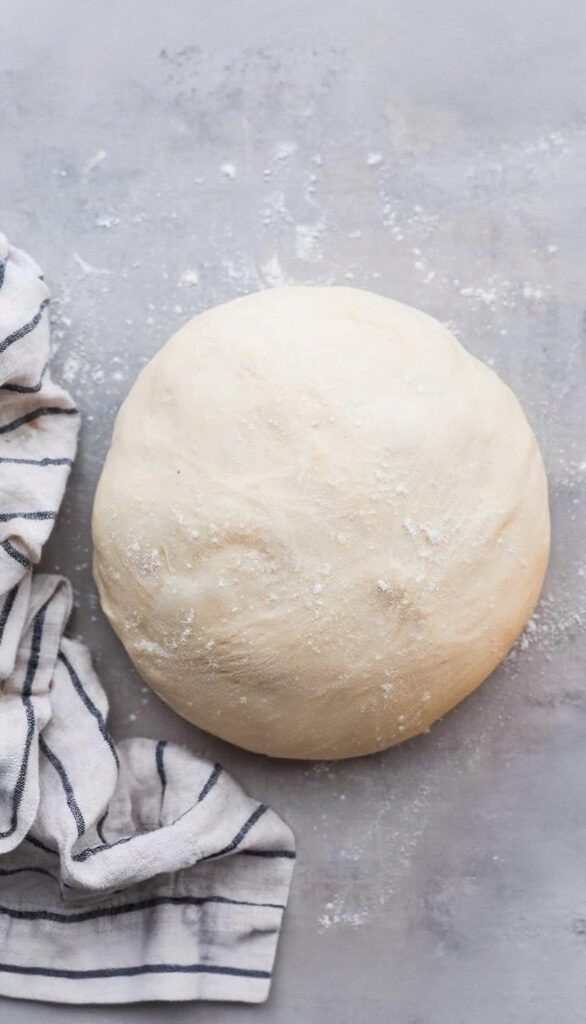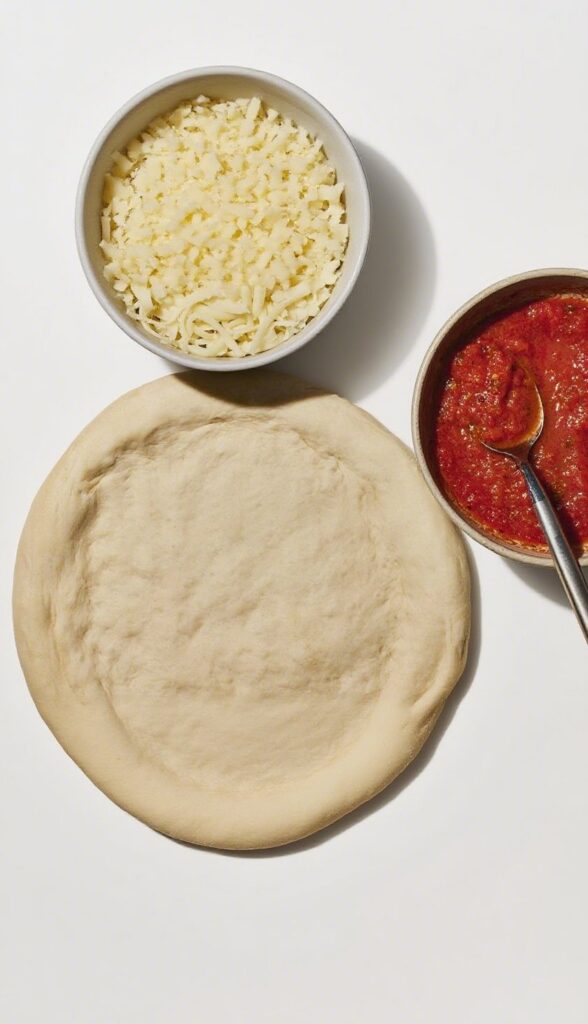Authentic Neapolitan Pizza Dough: The Ultimate Guide for Perfect Results

If you’ve ever taken a bite of a true Neapolitan pizza, you know there’s nothing quite like it. That delicate, blistered crust with a chewy interior and slightly sour tang comes from one place — the dough. This article dives deep into the heart of Neapolitan pizza dough, guiding you through its origin, ingredients, tools, and a step-by-step recipe that’ll bring authentic Naples flavor to your kitchen.
Check out our Veggie Pizza Healthy Recipe Guide for more great pizza ideas.
Understanding Neapolitan Pizza Dough Origins and Importance
What is Neapolitan Pizza Dough?
Neapolitan pizza dough is the traditional base of Italy’s most iconic pizza. Crafted with minimal ingredients—00 flour, water, salt, and yeast—it’s famous for its light, chewy texture, puffy crust, and delicate char.
This type of dough is all about simplicity and technique. Authenticity matters here, and even small deviations from the traditional method can affect the final product.
The History and Cultural Significance of Neapolitan Pizza
Originating in Naples in the 18th century, Neapolitan pizza quickly became a working-class staple. The dough evolved through generations of pizzaiolos (pizza makers) and was eventually recognized by the European Union with a Traditional Speciality Guaranteed (TSG) status.
Key Ingredients and Science Behind Neapolitan Dough
The Role of 00 Flour, Water, Salt, and Yeast
The four key ingredients form the dough’s core:
| Ingredient | Purpose |
|---|---|
| 00 Flour | Ultra-fine grind allows for soft, elastic dough. |
| Water (360g) | Hydrates flour and affects fermentation. |
| Salt (14g) | Regulates yeast activity and enhances flavor. |
| Yeast (0.2g – 0.5g) | Causes fermentation and rise; use fresh or dry. |
Tip: Use accurate digital kitchen scales to measure yeast (as low as 0.01g)!
Hydration Levels and Fermentation Time Explained
A 56–58% hydration level is typical for Neapolitan dough. This recipe follows a 24-hour room temperature fermentation, which helps develop flavor and texture without over-proofing. Learn more about cold fermentation in our Homemade BBQ Sauce guide.
Tools You Need for the Perfect Neapolitan Pizza Dough
Must-Have Pizza Dough Tools
| Tool | Function |
|---|---|
| Digital Kitchen Scales | Precise measurements (1g & 0.01g scale) |
| Mixing Bowl (Metal Preferred) | Lightweight and easy to clean |
| Pizza Proofing Box | Airtight box for ideal dough fermentation |
| Pizza Peel (12”) | For loading pizza into the oven |
| Turning Peel | Rotates pizza during cooking |
| Infrared Thermometer | Measures stone temp in pizza ovens |
Pizza Ovens vs Home Ovens: What Makes the Difference?
Pizza ovens like the Ooni Karu 16 hit 500°C (930°F), cooking pizza in 60–90 seconds. A home oven can work too—just preheat with a baking steel or stone at its max temp (260°C/500°F).
Step-by-Step Neapolitan Pizza Dough Recipe
How to Mix and Knead the Dough Correctly
- Mix Ingredients
Add water to a bowl first. Gradually mix in salt, yeast, and flour. Stir until a shaggy dough forms. - Autolyse Rest
Let the dough rest for 1 hour. - Knead by Hand
Knead gently for 5–8 minutes until smooth. - First Proof
Cover bowl with cling film or use a proofing box. Let it sit at room temperature for 20 hours. - Divide & Shape
Cut into four 250g dough balls. Place each in a covered container for another 4–6 hours.

The 24-Hour Prove Method: Best Practices for Timing
Don’t stress about precision. A window of 20–28 hours works well. Yeast amount should be adjusted based on your room temperature.
Don’t miss our Mini Pizza Bagels for more quick pizza snacks!
Shaping and Stretching the Dough Like a Pro
The Traditional Neapolitan Stretching Technique
- Flour your work surface.
- Press gently from the center of the dough outward.
- Avoid flattening the edges. That’s your crust!
- Flip, turn, and stretch to about 10 inches.
Tips to Avoid Dough Tearing and Crust Flattening
- Don’t press the crust.
- Don’t over-flour.
- Stretch slowly and rotate.
- If it tears, patch lightly and let it rest.
Creating the Authentic Neapolitan Pizza Sauce and Toppings
How to Make the Best No-Cook Tomato Sauce
Blend one tin (300g) of San Marzano tomatoes. Add a sprinkle of salt and pepper to taste. Optionally, add a tablespoon of tomato purée.
Note: Do not cook the sauce. Strain it slightly for thickness if needed.
Choosing the Right Cheese and Final Toppings
| Topping | Details |
|---|---|
| Mozzarella | Fresh, low-moisture preferred |
| Parmesan | Optional, added post-bake |
| Olive Oil | Drizzle before or after |
| Fresh Basil | Tear and place before or after baking |

Cooking Neapolitan Pizza at Home
Cooking with a Pizza Oven vs Regular Oven
- Pizza Oven: 450–500°C (850–930°F) – cooks in 60–90 seconds.
- Regular Oven: Preheat with stone at 260°C (500°F) – cook 6–8 minutes.
Turn pizza every 2–3 minutes or 20–30 seconds (pizza oven).
Covering Neapolitan Pizza at Home
Place on a dusted peel or board. Top gently with sauce and cheese. Cook immediately—delays may cause sticking or tearing.
Looking for inspiration? Try this Creamy Tomato Basil Tortellini
Troubleshooting Common Dough Issues
Dough Too Sticky or Dry?
- Add flour (if too sticky) or water (if dry).
- Knead briefly and let it rest.
- Use precise measurements and temperature control.
Crust Not Rising?
- You may have over-proofed or under-proofed.
- Avoid pressing the edges when shaping.
- Bake on a hot surface; check temp with an infrared thermometer.
Discover great kitchen techniques with our Whole30 Crispy Chicken Wings
FAQS:
What is the secret to Neapolitan pizza dough?
A 24-hour fermentation, minimal yeast, and 00 flour create the perfect flavor and texture.
What makes Neapolitan pizza dough different?
It’s ultra-hydrated, uses specific flour, and is fermented long at room temperature—resulting in a pillowy crust with charred spots.
How to make pizza Neapolitan dough?
Mix 00 flour, water, salt, and a pinch of yeast. Knead, ferment 24 hours, divide, and shape.
What is the 55 rule for pizza?
The 55 rule refers to hydration and fermentation balance—55–58% hydration with long fermentation for optimal texture.

Authentic Neapolitan Pizza Dough: The Ultimate Guide for Perfect Results
Make authentic Neapolitan pizza dough at home with this simple 4-ingredient recipe. Perfect for achieving that soft, chewy, blistered crust, just like in Naples. A 24-hour fermentation brings out rich flavor and airy texture.
- Total Time: ~24 hours 30 minutes
- Yield: Makes 4 x 10-inch pizzas 1x
Ingredients
For the Dough:
- 640g 00 flour
- 360g room temperature water
- 14g fine salt
- 0.2g to 0.5g instant yeast (or 3x more if using fresh yeast)
Toppings (Optional – Per Pizza):
- 2 tbsp San Marzano tomato sauce (pureed)
- 1/2 of a 125g mozzarella ball (drained)
- Grated Parmesan (optional, ~7g)
- 2–3 fresh basil leaves
- Olive oil (for drizzling)
- Salt and freshly ground pepper to taste
Instructions
-
Mix Dough:
In a large bowl, add the water first. Stir in salt and yeast until dissolved. Gradually mix in the flour until a shaggy dough forms. -
Autolyse:
Cover and let the dough rest for 1 hour at room temp. -
Knead:
Knead by hand for about 5 minutes until smooth. -
First Fermentation:
Place dough in the bowl or proofing box. Cover tightly. Let sit at room temperature (around 68–72°F) for 20 hours. -
Divide & Proof Again:
After bulk ferment, divide dough into 4 equal balls (250g each). Place into proofing containers and let rise for 4–6 more hours. -
Stretch & Shape:
Use your fingers to gently press from the center outward, pushing air to the crust. Do NOT press the crust. -
Top & Cook:
Add tomato sauce, mozzarella, basil, and other toppings.-
Pizza oven: 850–930°F (450–500°C) – Cook 60–90 seconds, turning.
-
Regular oven: 500°F (260°C) – Cook 6–8 minutes on a pizza stone or steel.
-
-
Serve:
Drizzle with olive oil, sprinkle Parmesan and fresh basil, and enjoy.
Notes
- Use digital scales to precisely measure yeast.
- Don’t refrigerate during fermentation. Room temp gives the best results.
- Remove moisture from mozzarella beforehand using paper towels.
- Always preheat your stone/steel 30 minutes before baking.
- Prep Time: 25 minutes
- Rest/Proof Time: 24 hours
- Cook Time: 60–90 seconds (pizza oven) OR 6–8 minutes (home oven)
- Method: Dough / Base
- Cuisine: Italian
- Diet: Vegetarian
Nutrition
- Calories: ~540 kcal
- Sodium: ~800mg
- Fat: 1g
- Carbohydrates: 110g
- Fiber: 4 g
- Protein: 16g






